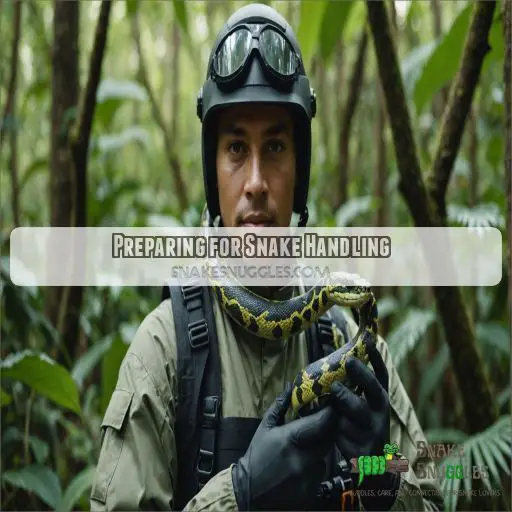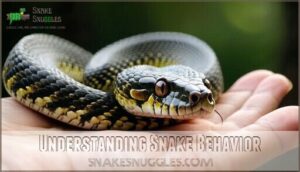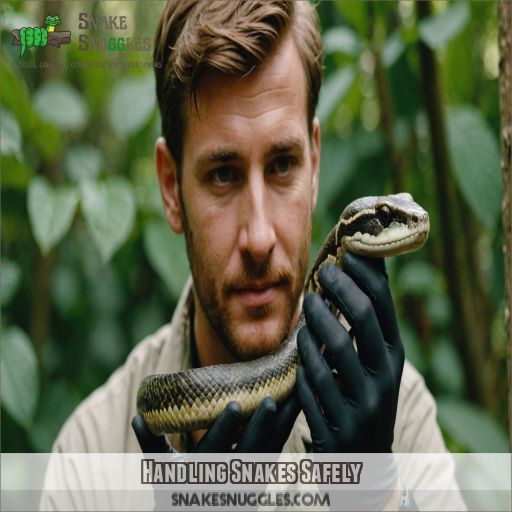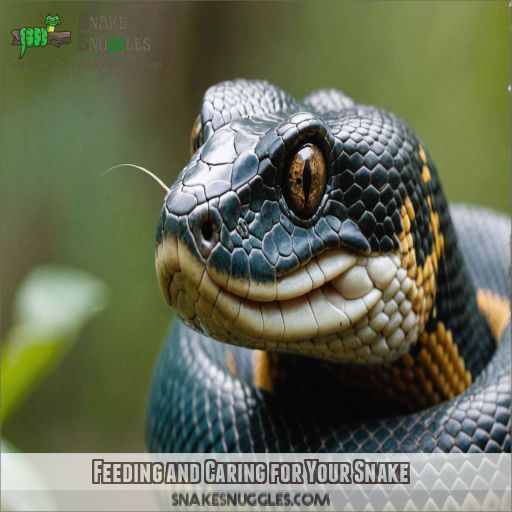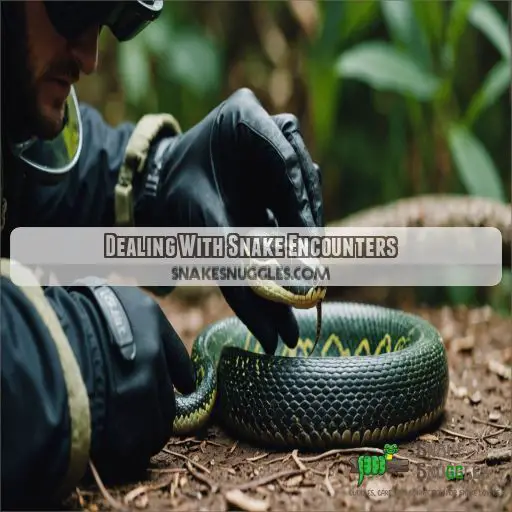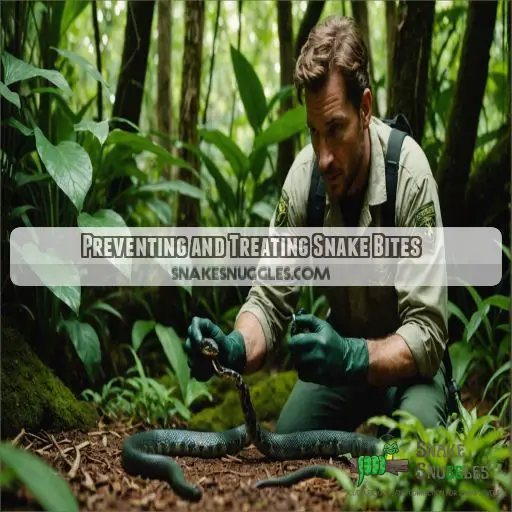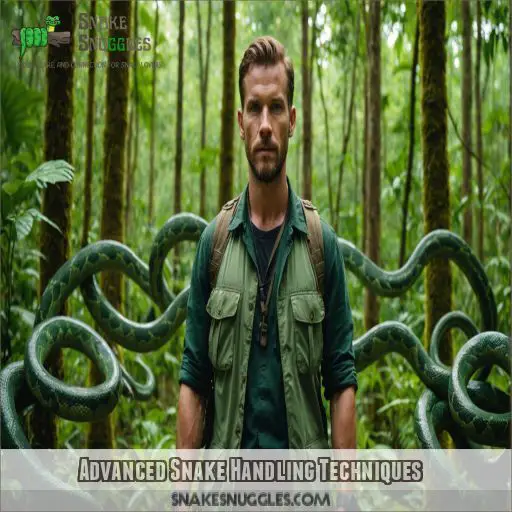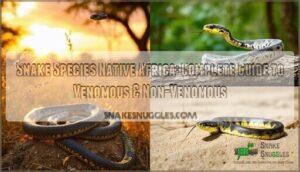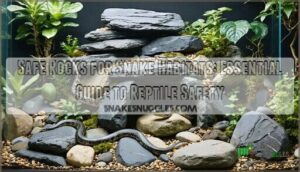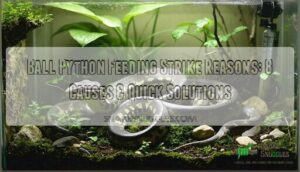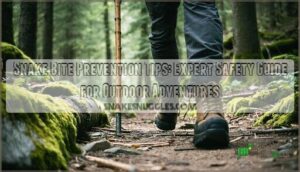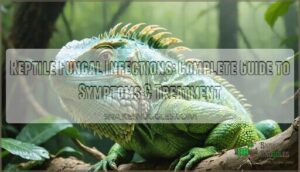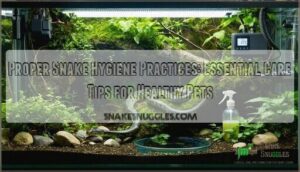This site is supported by our readers. We may earn a commission, at no cost to you, if you purchase through links.
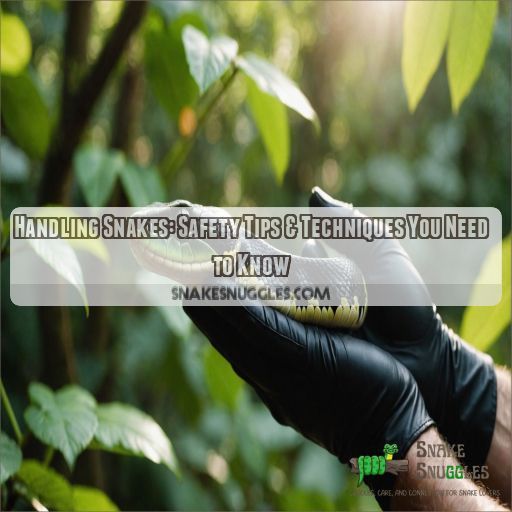 Handling snakes can feel like walking a tightrope, but it’s all about balance and caution.
Handling snakes can feel like walking a tightrope, but it’s all about balance and caution.
First, create a snake-proof haven by securing your yard and enclosures.
Equip yourself with a snake hook and gloves, like a knight donning armor, not forgetting to sanitize everything.
When handling, approach slowly, pick up gently, and support the snake’s midsection to conquer any fear of falling.
Oh, and mind those aggressive signals: a rattling tail is nature’s alarm clock!
Ready to shed light on more handling secrets? Stay tuned, because there’s a world to unravel!
Table Of Contents
- Key Takeaways
- Preparing for Snake Handling
- Understanding Snake Behavior
- Handling Snakes Safely
- Feeding and Caring for Your Snake
- Dealing With Snake Encounters
- Preventing and Treating Snake Bites
- Advanced Snake Handling Techniques
- Frequently Asked Questions (FAQs)
- Do snakes like being handled?
- What does the Bible say about handling snakes?
- Is there a proper way to hold a snake?
- How to handle the snake?
- What are the dietary requirements for pet snakes?
- Can non-venomous snakes interbreed with venomous ones?
- How can I identify a snake’s species accurately?
- What precautions should I take when housing multiple snakes?
- Are there legal regulations for keeping snakes as pets?
- Conclusion
Key Takeaways
- Snake-proof your space: Secure your yard and create safe enclosures to keep snakes out. Maintain a clutter-free, child-safe, and pet-safe environment.
- Gear up: Invest in a snake hook and gloves for handling. Always have a sanitized first aid kit on hand. Wear protective gear to minimize the risk of snakebites.
- Decode body language: Look out for defensive signals like a raised head, rapid eye movements, and tail rattling. Handle snakes when they appear relaxed, and avoid making sudden movements that might startle them.
- Know your snakes: Learn to identify venomous species and how to remove them safely from your home. Prevent bites by maintaining a calm presence, using proper techniques, and ensuring secure enclosures.
Preparing for Snake Handling
Before you try your hand at snake handling, it’s really important to prepare by creating a safe environment and sanitizing your tools and hands. Think of it as setting up a stage for a drama-free performance!
You should choose the right equipment, but wearing protective gear is like having a trusty sidekick while ensuring both you and your snake remain calm and unscathed.
Creating a Safe Environment
When creating a snake-safe environment, focus on:
- Ensuring your yard is snake-proof and free from clutter.
- Setting up a secure enclosure.
- Maintaining a child and pet-safe area.
Choosing the Right Equipment
When handling snakes, it’s really important to have the right equipment. Keep a snake hook, handling gloves, and a first aid kit handy for safe and secure handling.
| Equipment | Purpose |
|---|---|
| Snake Hook | Move/control snake safely |
| Handling Gloves | Protect hands from bites |
| Enclosure Setup | Secure snake’s habitat |
| Feeding Tools | Safe food delivery |
| First Aid Kit | Manage bite emergencies |
Choose tools wisely to master snake handling!
Sanitizing Your Hands and Equipment
Before diving into snake handling, remember: clean hands, clean tools! Use disinfectants to banish germs. No one wants a sneaky snake sniffing out dinner on your fingers—equipment safety first!
Wearing Protective Gear
Wearing protective gear, like sturdy gloves and a snake hook, is really important for safely handling snakes. Don’t take chances – gear up to avoid nasty bites!
Understanding Snake Behavior
Handling snakes might seem like trying to read a friend’s mood after a long day—tricky but manageable once you know the signs. Understanding their behavior is key, from busting myths to recognizing when they’re feeling a bit cranky or laid-back.
Common Myths About Snakes
Snake myths can fool anyone! Snakes aren’t out for revenge or plotting danger like villains. They prefer to be left alone. Understanding snake behavior helps when handling or providing proper care.
Recognizing Aggressive Behavior
So, you’ve busted some myths about snakes. Recognizing aggressive behavior now is key. Look for warning signs like tail rattling, quick eye movement, or a tense, defensive posture. Stay snake-safe!
Understanding Body Language
When reading snake posture, pay attention to defensive signals. A raised head often indicates alertness. Watch tail movements for stress clues, and eyes or tongue flicks might reveal curiosity or caution.
Knowing When to Handle Snakes
You’ll need a sixth sense for snake handling. Observe their temperament and stress levels. Handle when they’re relaxed, not shedding or recently fed. Timing’s key—follow handling guidelines for safe, stress-free interactions.
Handling Snakes Safely
When handling snakes, it’s really important to approach them gently and keep movements slow to avoid startling them, as sudden motions can trigger fear or defensive behavior. You’ll want to pick them up by supporting their entire body, ensuring both your safety and the snake’s comfort.
Approaching the Snake
Now that you’ve grasped snake behavior, time to approach your slithery friend. Use slow, deliberate movements, like a cautious dance partner. Always side approach, observing snake body language, ensuring a calm encounter.
Picking Up the Snake
When picking up your snake, use a gentle, confident grip around its midsection. Avoid grabbing the head or tail, which can stress the snake and lead to an unpleasant encounter.
Supporting the Snake’s Body
When supporting a snake’s body, guarantee even weight distribution, keeping a gentle hold. Use:
- Safe grip
- Body positioning
- Tail support
- Handling techniques
Avoiding Sudden Movements
Supporting a snake’s body smoothly minimizes their anxiety. Avoid sudden movements—they’re like jumping jacks for snakes. Instead, practice steady, calm handling to create predictable interactions. Here’s some snake handling advice:
| Snake Handling Tips | Snake Encounter Advice | Snake Handling Protocols |
|---|---|---|
| Stay calm | Keep your distance | Use smooth movements |
| Secure grip | Assess the situation | Slow, steady approach |
| Respect the snake | Call for help if needed | Gradual, predictable actions |
Feeding and Caring for Your Snake
When it comes to feeding and caring for your snake, knowing the right techniques and environment can prevent awkward surprises, like a snake thinking your finger’s a snack. From choosing the best meals to monitoring your slithery friend’s health, you’ll keep your snake happy and avoid any hissy fits.
Feeding Techniques
Avoid feeding snakes in their enclosure to prevent associating your hand with food. Feed them in a separate container to minimize bite risk. Use tongs to offer prey safely.
Choosing the Right Food
When selecting your snake’s meals, think like a master chef! Match prey size to your snake’s needs. Mix live or frozen options. Find balance: diet fuels snake-handling mastery.
Providing a Suitable Environment
After choosing the right food, it’s time to make certain your snake’s environment is cozy. Think balanced temperature, ideal humidity, and suitable enclosure size. Don’t forget enrichment activities for a happier snake!
Monitoring Health and Hygiene
- Sanitize enclosures regularly.
- Recognize health issues early.
- Maintain proper humidity diligently.
Dealing With Snake Encounters
When dealing with snake encounters, it’s important to know how to handle both outdoor and indoor situations safely. Snakes aren’t out to get you, but learning to identify venomous ones and removing them properly can avoid any unnecessary drama in your life.
Outdoor Encounters
You’ve fed your snake, now what if you spot one outdoors? Stay calm! Use snake identification: venomous or not? Keep a safe distance, leave the snake alone, and call professionals.
Indoor Encounters
Shifting from outdoor to indoor snake encounters, prioritize home safety. Identify the snake, employ trap types like glue boards, and consider contacting a snake removal company if you’re unsure about handling it.
Identifying Venomous Snakes
Spotting venomous snakes can feel like staring at a puzzle, but don’t fret! Look for:
- Triangular heads
- Elliptical eyes
- Distinct patterns
- Rattle or hood
- Pit organs
Happy hunting—just kidding! Stay safe!
Removing Snakes From Your Home
After identifying the snake, it’s time for action. Use humane snake traps or diy removal methods, ensuring non-lethal deterrents are in place. When stumped, contact a snake control expert.
Preventing and Treating Snake Bites
When dealing with snakes, it’s important to know how to prevent bites and what to do if bitten. Keep your wits about you and remember: a calm mind is your best defense when encountering these slithery creatures.
Preventing Bites
To prevent snake bites, always keep your cool and watch for signs of aggression. Use proper handling techniques and equipment. Secure your snake enclosure to stop escape attempts.
Treating Non-Venomous Bites
Even with non-venomous snake bites, proper wound care is key:
- Clean the wound with antiseptic.
- Apply pressure to stop bleeding.
- Dress it securely.
- Seek snake resources for guidance.
Treating Venomous Bites
If bitten by a venomous snake, remain calm. Identify the snake, apply pressure, and seek immediate medical attention. Antivenom may be required to counteract the venom’s effects.
First Aid and Emergency Response
Now, let’s talk about first aid. Start by staying calm if bitten. Check your first aid kit for snakebite symptoms. Contact emergency services for antivenom and follow their guidance. Stay safe!
Advanced Snake Handling Techniques
In the adventurous world of snake handling, you’ll sometimes need to face the challenge of managing venomous or larger snakes with finesse. It’s like juggling, but with a bit more adrenaline and having the right tools and skills makes sure everyone stays safe.
Handling Venomous Snakes
When handling venomous snakes, identify them accurately. It’s a must! Use proper safety gear. Know venomous snake behavior, and never skimp on antivenom supplies. Ethical handling is key, folks!
Handling Large or Aggressive Snakes
Handling large or aggressive snakes requires extra caution. Consider their size, strength, and unpredictability. Use specialized restraint techniques, maintain a secure enclosure, and minimize bite risk.
Using Specialized Equipment
Handling large snakes is no picnic. Equip yourself with snake hooks and safety gear, plus learn to use handling tools and capture devices. Here’s a helpful table to guide your choices:
| Equipment | Use | Pros | Cons |
|---|---|---|---|
| Snake hooks | Moving snakes safely | Keeps distance | Requires practice |
| Handling tools | Support and lift snakes | Maneuverability | Can be bulky |
| Safety gear | Personal protection | Reduces injury risk | Can limit dexterity |
| Capture devices | Temporarily contain snakes | Help maintain control | May stress snake |
Advanced Safety Precautions
When handling snakes, think of yourself as a cautious snake whisperer. Practice snake bite prevention with proper snake restraint techniques, guarantee snake enclosure safety, and always have emergency protocols ready.
Frequently Asked Questions (FAQs)
Do snakes like being handled?
Think of snakes like introverted roomies; they don’t mind a little company occasionally, but they really value their alone time. Respect their nature, handle them gently, and they’ll tolerate your visits without slithering off in distaste.
What does the Bible say about handling snakes?
The Bible mentions handling snakes in Mark 16:17-18, but it’s controversial and debated. The text implies divine protection, not a command to handle snakes. Testing God by intentionally handling snakes isn’t advised .
Is there a proper way to hold a snake?
Did you know 68% of snake bites occur on the hands? To properly hold a snake, approach calmly from the side, support its body gently, and keep it away from your face, ensuring both you and the snake stay safe.
How to handle the snake?
To handle a snake, first get it used to your presence. Wash your hands, then rest them in its cage for a few minutes, twice a day. Move slowly, and approach from the side. Handle when it’s tired but awake, and avoid post-feeding or pre-shedding. Use gloves and a snake hook for safety.
What are the dietary requirements for pet snakes?
All snakes are carnivores and their diet depends on their species. They eat whole prey, including rodents, birds, amphibians, reptiles, fish, eggs, and insects. Some snakes have specialized diets, like the African Egg-Eating Snake, which eats quail eggs.
Can non-venomous snakes interbreed with venomous ones?
It’s a no-go for venomous and non-venomous snakes to mate—they’re as different as chalk and cheese. These snakes are just too biologically mismatched, and there’s no record of them producing hybrid babies.
How can I identify a snake’s species accurately?
If you’re looking to identify a snake species, you can look out for certain characteristics. These include body type, head shape, eye shape and color, scale texture, patterns, and tail shape. You can also use snake reference websites, books, or apps.
What precautions should I take when housing multiple snakes?
Slithery sidekicks? Sure, but proceed with caution. Snakes are solitary souls, so mixing multiple species or genders in one enclosure can trigger territorial tendencies. Keep males and females apart unless you’re ready for baby snakes. Same-sized snakes of similar species are your safest bet.
Are there legal regulations for keeping snakes as pets?
Keeping snakes as pets is regulated by federal, state, and local laws. While reptiles are legal in most places, some states and localities may have restrictions or bans on certain breeds. Check your local US Fish and Wildlife office for specifics. You may need a permit for certain species, especially if they’re venomous.
Conclusion
Handling snakes can be a delicate process, much like walking a tightrope.
But with the right knowledge and preparation, you can do it safely and confidently.
We’ve explored the secrets of snake handling, from creating a snake-proof environment to understanding their behavior and body language.
Now, you’re equipped with the techniques and tips needed to handle these fascinating creatures.

